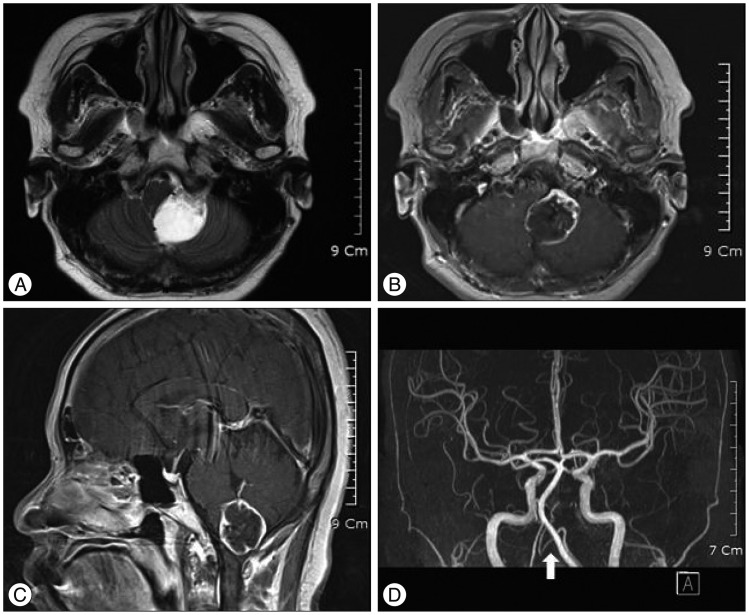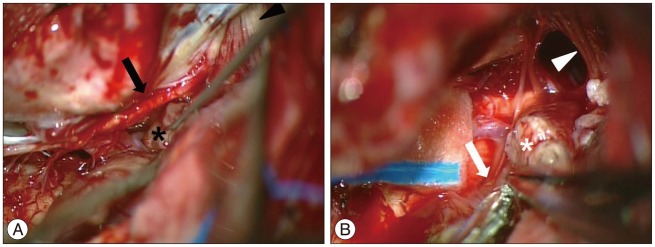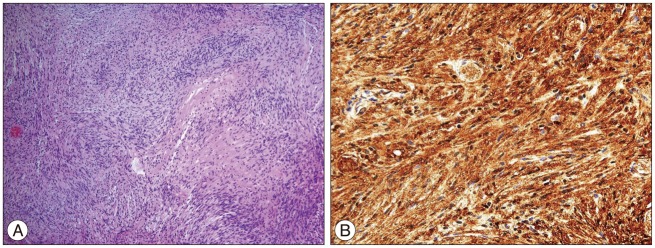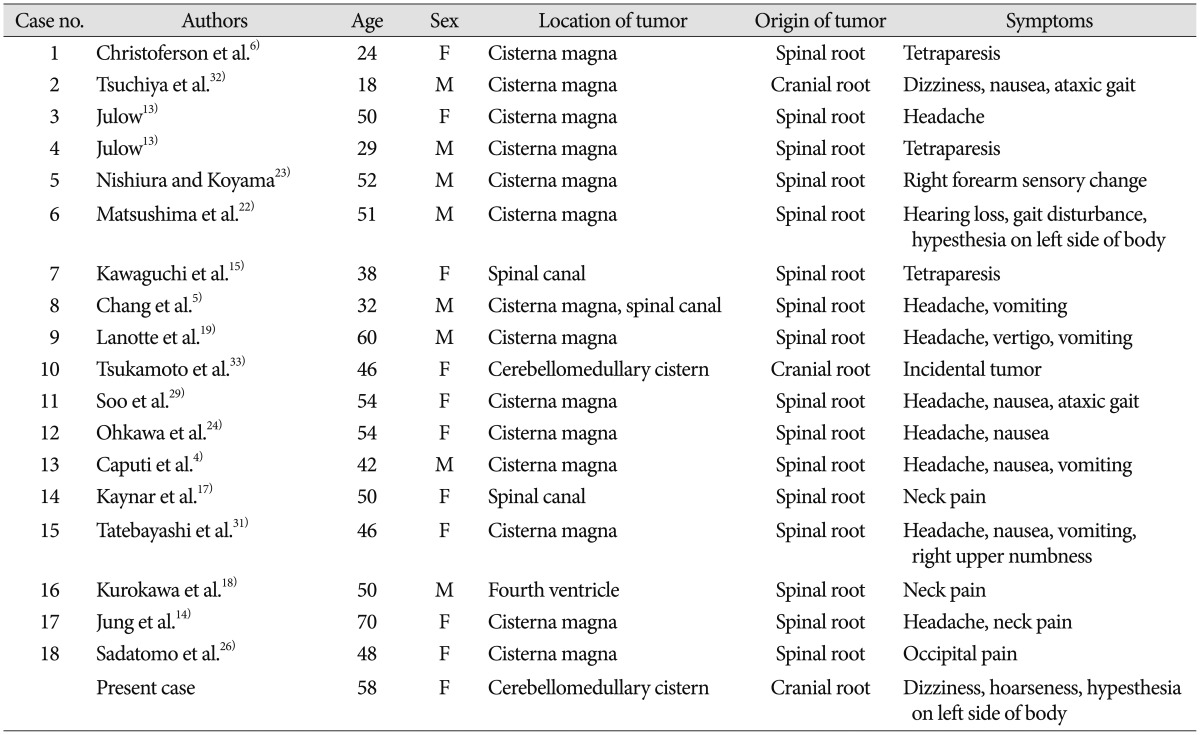1. Bakar B. The jugular foramen schwannomas : review of the large surgical series. J Korean Neurosurg Soc. 2008; 44:285–294. PMID:
19119464.

2. Benninger B, McNeil J. Transitional nerve : a new and original classification of a peripheral nerve supported by the nature of the accessory nerve (CN XI). Neurol Res Int. 2010; 2010:476018. PMID:
21318044.
3. Bulsara KR, Sameshima T, Friedman AH, Fukushima T. Microsurgical management of 53 jugular foramen schwannomas : lessons learned incorporated into a modified grading system. J Neurosurg. 2008; 109:794–803. PMID:
18976067.

4. Caputi F, de Sanctis S, Gazzeri G, Gazzeri R. Neuroma of the spinal accessory nerve disclosed by a subarachnoid hemorrhage : case report. Neurosurgery. 1997; 41:946–950. PMID:
9316059.

5. Chang KC, Huang JS, Liu KN, Tsai CS, Chen TY. Neurinoma of the spinal accessory nerve : report of a case. J Formos Med Assoc. 1990; 89:593–597. PMID:
1979603.
6. Christoferson LA, Leech RW, Grossman M. Intracranial neurilemoma of the spinal accessory nerve. Surg Neurol. 1982; 18:18–20. PMID:
7112381.

7. de Oliveira E, Rhoton AL Jr, Peace D. Microsurgical anatomy of the region of the foramen magnum. Surg Neurol. 1985; 24:293–352. PMID:
4023912.

8. DeToledo JC, David NJ. Innervation of the sternocleidomastoid and trapezius muscles by the accessory nucleus. J Neuroophthalmol. 2001; 21:214–216. PMID:
11725190.

9. DeToledo JC, Dow R. Sternomastoid function during hemispheric suppression by amytal : insights into the inputs to the spinal accessory nerve nucleus. Mov Disord. 1998; 13:809–812. PMID:
9756150.

10. Falla D, Dall'Alba P, Rainoldi A, Merletti R, Jull G. Repeatability of surface EMG variables in the sternocleidomastoid and anterior scalene muscles. Eur J Appl Physiol. 2002; 87:542–549. PMID:
12355194.

11. Fink LH, Early CB, Bryan RN. Glossopharyngeal schwannomas. Surg Neurol. 1978; 9:239–245. PMID:
675473.
12. Hakuba A, Hashi K, Fujitani K, Ikuno H, Nakamura T, Inoue Y. Jugular foramen neurinomas. Surg Neurol. 1979; 11:83–94. PMID:
424988.
13. Julow J. Neurinoma of spinal accessory nerve. Report of two cases. Acta Neurochir (Wien). 1983; 69:219–224. PMID:
6650236.
14. Jung TY, Jung S, Kim IY, Kang SS. Intracisternal schwannoma of the spinal accessory nerve : a case report. Skull Base. 2006; 16:175–179. PMID:
17268591.

15. Kawaguchi S, Ohnishi H, Yuasa T, Hashimoto H. [Spinal accessory nerve neurinoma in the C2 spinal canal. Case report]. Neurol Med Chir (Tokyo). 1987; 27:1190–1194. PMID:
2452367.
16. Kaye AH, Hahn JF, Kinney SE, Hardy RW Jr, Bay JW. Jugular foramen schwannomas. J Neurosurg. 1984; 60:1045–1053. PMID:
6716139.

17. Kaynar MY, Hanci M, Sarioğlu AC. Intraspinal schwannoma of the accessory nerve. Br J Neurosurg. 1999; 13:429–431. PMID:
10616577.

18. Kurokawa R, Tabuse M, Yoshida K, Kawase T. Spinal accessory schwannoma mimicking a tumor of the fourth ventricle : case report. Neurosurgery. 2004; 54:510–514. discussion 514. PMID:
14744299.

19. Lanotte M, Massaro F, Scienza R, Faccani G. Intracisternal schwannoma of the spinal accessory nerve presenting as a normal pressure hydrocephalus syndrome. Case report and review of the literature. Neurosurg Rev. 1994; 17:225–227. PMID:
7838403.

20. Leonetti JP, Anderson DE, Marzo SJ, Origitano TC, Shirazi M. Intracranial schwannomas of the lower cranial nerves. Otol Neurotol. 2006; 27:1142–1145. PMID:
17130803.

21. Linn J, Moriggl B, Schwarz F, Naidich TP, Schmid UD, Wiesmann M, et al. Cisternal segments of the glossopharyngeal, vagus, and accessory nerves : detailed magnetic resonance imaging-demonstrated anatomy and neurovascular relationships. J Neurosurg. 2009; 110:1026–1041. PMID:
19199448.

22. Matsushima T, Fukui M, Matsunaga M, Kitamura K, Hasuo K. Accessory nerve neurinoma mimicking a brain stem tumor on angiography : report of a case. Neurosurgery. 1985; 16:839–842. PMID:
3874371.

23. Nishiura I, Koyama T. Neurinoma of the spinal accessory nerve. A case report. Neurochirurgia (Stuttg). 1984; 27:154–157. PMID:
6493421.

24. Ohkawa M, Fujiwara N, Takashima H, Satoh K, Tanabe M, Honjo Y, et al. Radiologic manifestation of spinal accessory neurinoma : a case report. Radiat Med. 1996; 14:269–273. PMID:
8988507.
25. Pearson AA, Sauter RW, Herrin GR. The accessory nerve and its relation to the upper spinal nerves. Am J Anat. 1964; 114:371–391. PMID:
14167167.

26. Sadatomo T, Yuki K, Migita K, Hidaka T, Kurisu K. [Accessory nerve sch-wannoma of the intracisternal type : a case report]. No Shinkei Geka. 2010; 38:831–837. PMID:
20864772.
27. Sedney CL, Nonaka Y, Bulsara KR, Fukushima T. Microsurgical management of jugular foramen schwannomas. Neurosurgery. 2013; 72:42–46. discussion 46. PMID:
23096422.

28. Shiroyama Y, Inoue S, Tsuha M, Abiko S, Aoki H. [Intracranial neurinomas of the jugular foramen and hypoglossal canal]. No Shinkei Geka. 1988; 16:313–319. PMID:
3287206.
29. Soo SJ, Irie K, Fujiwara T, Kuyama H, Nagao S. [A case of accessory nerve neurinoma presenting an intracisternal tumor]. No Shinkei Geka. 1995; 23:723–726. PMID:
7666945.
30. Sperti L, Midrio M, Xzmin E. Effects of selective intracranial section and stimulation of vago-accessory roots. IV. Reflex activity of 'accessory' cardio-inhibitory neurons. Experientia. 1962; 18:97. PMID:
13915736.

31. Tatebayashi K, Tanaka Y, Numata H, Kawakami S, Kamitani H, Watanabe T. Schwannoma of the spinal accessory nerve in the cisterna magna. Surg Neurol. 2003; 59:217–222. discussion 222. PMID:
12681558.

32. Tsuchiya K, Machida T, Maehara T, Iio M. [Case of accessory nerve neurinoma]. Rinsho Hoshasen. 1982; 27:1375–1378. PMID:
7161915.
33. Tsukamoto H, Hikita T, Takaki T. Cerebellopontine angle meningioma associated with cranial accessory nerve neurinoma--case report. Neurol Med Chir (Tokyo). 1994; 34:225–229. PMID:
7520545.

34. Tubbs RS, Shoja MM, Loukas M, Lancaster J, Mortazavi MM, Hattab EM, et al. Study of the cervical plexus innervation of the trapezius muscle. J Neurosurg Spine. 2011; 14:626–629. PMID:
21388290.








 PDF
PDF ePub
ePub Citation
Citation Print
Print



 XML Download
XML Download